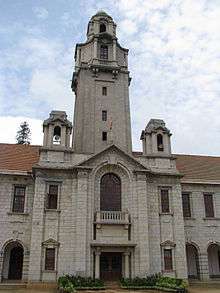Ambarish Ghosh
| Ambarish Ghosh | |
|---|---|
|
| |
| Born |
December 18, 1973 Kolkata, India |
| Residence | Bangalore, Karnataka, India |
| Nationality | Indian |
| Alma mater | |
| Awards | |
| Scientific career | |
| Fields |
|
| Institutions | |
| Doctoral advisor | Humphrey Maris |
| Website | http://www.cense.iisc.ac.in/ambarish/ |
Ambarish Ghosh is an Indian scientist, an Associate Professor at the Centre for Nano Science and Engineering(CeNSE), Indian Institute of Science, Bangalore. He is known for his work on nanorobots, active matter physics, Plasmonics and Nanophotonics and liquid helium.
Research work

Magnetic nanorobots
In 2009 he along with Peer Fischer demonstrated the use of glancing-angle deposition to fabricate magnetic helical nanoswimmers,.[1] His group figured out the dynamics of such nanorobots[2] and presented techniques for independent control of such robots.[3] In recent years his group has managed to demonstrate the various applications of helical nanorobots including techniques to move in blood.[4] This includes the use of nanorobots in active colloidal manipulation [5] and as probes for sensing the environment inside living cells.[6][7]
Plasmonics and Metamaterials
Ambarish Ghosh and his group has developed a wafer scale technology to fabricate porous 3D plasmonic metamaterial which can be used over a wide range of wavelengths, including the visible. This technology allows a wide range of materials and geometries, and therefore highly versatile. They have used Glancing Angle Deposition for generating various porous 3D dielectric structures and have integrated plasmonics to develop an arrangement of metal-dielectric layers in 3D. Very recently, they have demonstrated a conceptually novel method to integrate plasmonic nanoparticles with graphene, allowing them to achieve unprecedented EM field enhancement and photodetection sensitivity.
Awards and honors
The Council of Scientific and Industrial Research, the apex agency of the Government of India for scientific research, awarded him the Shanti Swarup Bhatnagar Prize for Science and Technology for his contributions to physical sciences in 2018.[8]
References
- ↑ Ghosh, A.; Fischer, P. (2009). "Controlled Propulsion of Artificial Magnetic Nanostructured Propellers". Nano Letters. 9 (6): 2243–2245. doi:10.1021/nl900186w.
- ↑ Ghosh, A. et. al. (2013). "Analytical theory and stability analysis of an elongated nanoscale object under external torque". Phys. Chem. Chem. Phys. 15 (26). doi:10.1039/C3CP50701G.
- ↑ Mandal, P. et. al (2015). "Independent positioning of magnetic nanomotors". ACS Nano. 9 (5). doi:10.1021/acsnano.5b01518.
- ↑ https://www.nanowerk.com/spotlight/spotid=35255.php
- ↑ Ghosh, S.; Ghosh, A. (2018). "Mobile nanotweezers for active colloidal manipulation". Science Robotics. 3 (14). doi:10.1126/scirobotics.aaq0076.
- ↑ Pal, M. et. al. (2018). "Maneuverability of Magnetic Nanomotors Inside Living Cells". Advanced Materials. 30 (22). doi:10.1002/adma.201800429.
- ↑ Ghosh, A. et. al. (2018). "Helical Nanomachines as Mobile Viscometers". Advanced Functional Materials. 28 (25). doi:10.1002/adfm.201705687.
- ↑ "Shanti Swarup Bhatnagar Prize (SSB) for Science and Technology 2018" (PDF). Shanti Swarup Bhatnagar Prize. 2018-09-26. Retrieved 2018-09-26.